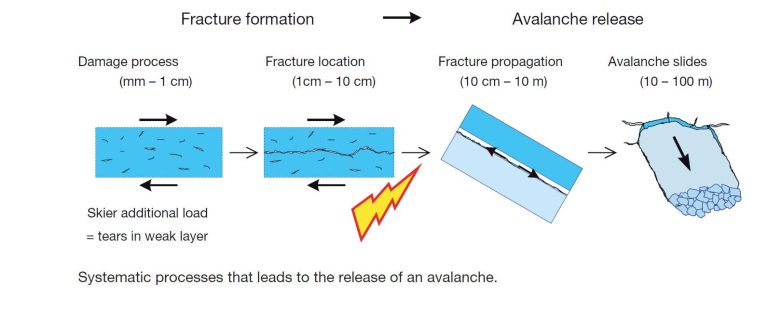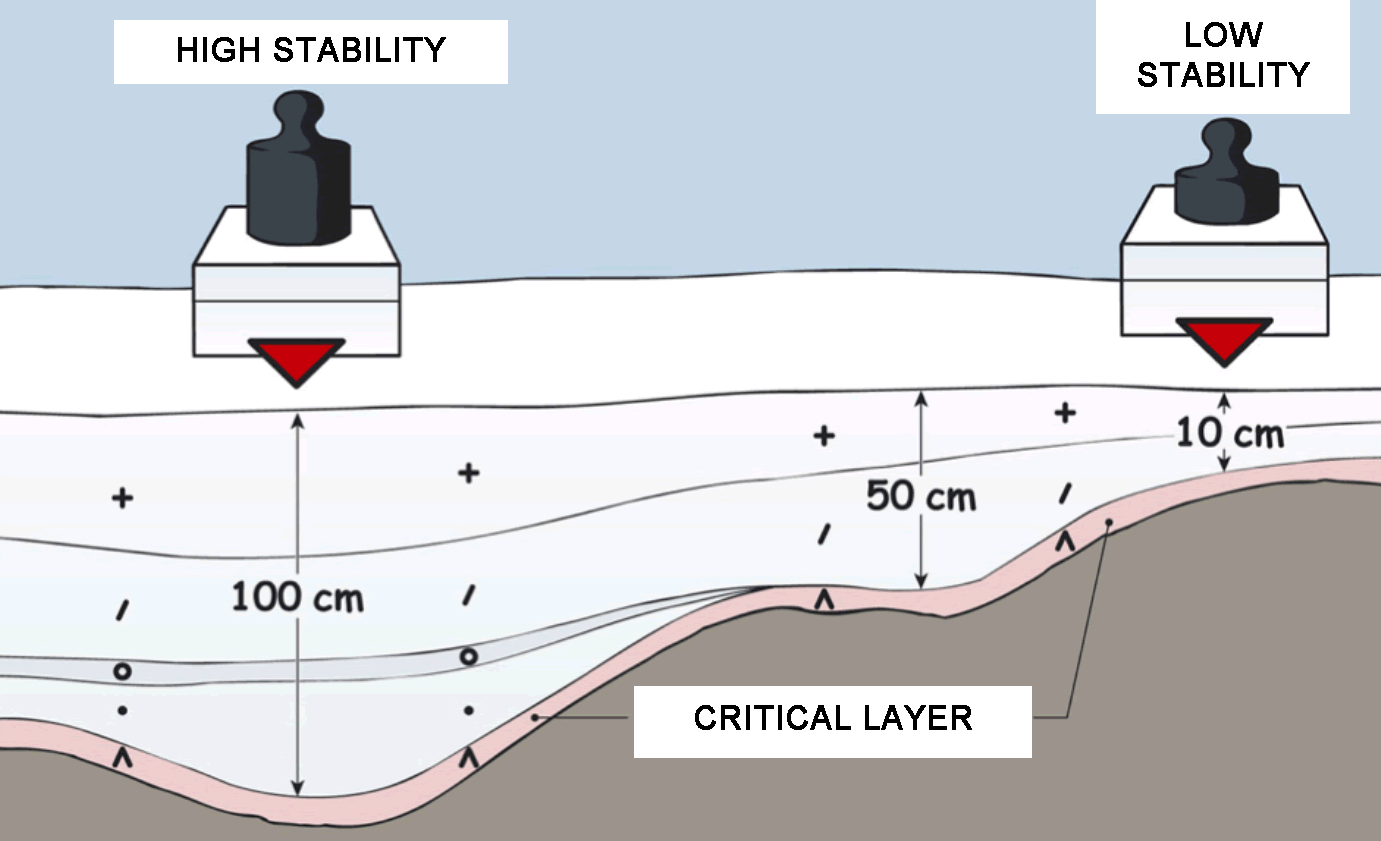Here is some general information about avalanches that is very useful when touring or freeriding in the backcountry or off the beaten path.
How is an avalanche triggered?
An avalanche can be triggered spontaneously or by an additional load on the snowpack and a disturbance of the weak layers in the snowpack. An additional load can be either a low or a high.
Low additional load: single skiers or a group with distance adapted to the slope and the situation.
High additional load: Two or more skiers in a group with insufficient distance between them or a fall on the snow surface.

If there is a weak layer in the snowpack, one or more skiers can damage the weak layer or layers in the snowpack by their sudden loading. You sink in, then the area collapses under the load and the pressure then goes to the point of highest stress in the weak layer after the snowpack collapses, and then the break takes place; the weak layer can collapse and spread over a larger area within the snowpack (propagation).
If the weak layer is deeper in the snowpack, it will not be damaged. However, the weaker layers near the surface of the snowpack are more affected than the weaker layers deeper in the snowpack.
The thinner, weaker layers are more susceptible to braking, with additional loading as the thin layer cannot withstand the pressure applied from above, while a thicker, weak layer can withstand additional loading and is more stable/favorable when pressure is applied from above, depending on the characteristics of the area in the snowpack.
A weak layer that is closer to the surface of the snowpack is more likely to break if an additional load is applied. Conversely, the deeper the weak layer, the more it is protected by the snowpack and will not be disturbed unless the snowpack is heavily loaded, e.g., by a large group of skiers all skiing together with insufficient distance between them.

It may also depend on some factors in the old snowpack.
The depth of the weak layer
How many weak layers are present in the snowpack
The thickness of the weak layer
The thickness of the snow cover (soft/hard/decreasing)
Size of avalanches and their impact?
Avalanches can be classified into five different sizes based on the damage caused by the avalanche, the mass and dimensions of the avalanche, and the distance the avalanche travels.
1. slide
Possible damage:
Unlikely to topple a person and relatively harmless
In extreme terrain there is a risk of crashing
Outlet:
Comes to a standstill in steep terrain
Typical dimensions:
Length – 10 m
Volume – 100 m3
2. small avalanche
Possible damage:
Can bury, injure or kill people
Outlet:
Can reach the end of the respective slope
Typical dimensions:
Length – 50 / 100 m
Volume – 1000 m3
3. medium avalanche
Possible damage:
Can bury and destroy cars, damage trucks, destroy small buildings and knock down a few trees
Outlet:
Can slide to the bottom of the ski slope from where it was triggered
Typical dimensions:
Length – 500 m
Volume – 10,000 m3
4. big avalanche
Possible damage:
Can bury and destroy trucks and trains Can destroy relatively large buildings and small forest areas
Large avalanches can occur at hazard level 3 and are typical of hazard levels 4 and 5
Outlet:
Crosses flat terrain (well below 30°) over a distance of more than 50 m
May reach the bottom
Typical dimensions:
Length – 1 / 2 km
Volume – 100.000 m3
5. very large avalanche
Possible damage:
Can wreak havoc on the landscape and has catastrophic destructive potential
Typical for security level 5
Outlet:
Reaches the bottom
Largest known avalanche
Typical dimensions:
Length – 3 km and more
Volume – 100,000 m3 and more
What are the types of avalanches?
Avalanches are not all the same, and there are significant differences between individual avalanches. The most common avalanche we deal with is the snow slab avalanche, which is especially dangerous for freeriders/backcountry skiers and ski tourers during the winter months in Europe.

Snow slab avalanches
Snow slab avalanches have a clear, wide fault line. They can only occur when a bound layer of snow (the snow slab) lies on a weak layer over a sufficiently large area. The release requires the application of an additional load and an angle of inclination of at least 30°. The avalanche is triggered by a small crack that initially occurs in the weak layer (initial failure) and then rapidly propagates across it. The extent of fracture propagation depends on the properties of the weak layer and the overlying slab.
Snow slab avalanches can occur in dry or wet snow, even long after a snowfall. They can be triggered naturally (without human intervention) or at any point inside or even outside (in the case of remote triggering) at the edge of the plate. Snow slab avalanches are the most dangerous type of avalanche and are responsible for more than 90% of avalanche fatalities.
Snow slab avalanches can be dangerous, even if they are not large. They quickly reach a high speed. A person who triggers a snow slab is often inside the snow slab and is caught in the avalanche.
Loose snow avalanches
Loose snow avalanches fan out from a release point, tumbling downhill and carrying more and more snow with them. This type of avalanche often occurs during or shortly after snowfall or during strong warming. A loose snow avalanche consisting of dry powder snow usually requires a slope angle of 40°. Especially in wet snow, these avalanches can reach considerable dimensions in persistently steep terrain.
Loose snow avalanches are often triggered naturally. A freerider who triggers a loose snow avalanche is rarely buried, as it slides away from him down the slope and usually only triggers small masses of snow.
Gliding avalanches
Like snow slab avalanches, sliding snow avalanches have a pronounced, broad incipient line, but differ in that the entire snowpack is triggered. They can only occur on a smooth surface, which is typically flattened grass or rock slabs. The steeper the slope, the greater the risk that the snow will slide off.
Gliding avalanches can be a major problem for traffic routes, especially during snowy winters. For winter sports enthusiasts, they are only of secondary importance because they are rarely triggered by humans. These avalanches are triggered naturally when the friction at the interface with the ground decreases because the snow at the base of the snowpack becomes wet. Water can penetrate the bottom layer in two different ways:
In high winter, the snow cover is usually cold and dry. During this time, it becomes moist from below, either because the warm ground melts the snow above, or because the snow absorbs water from the moist ground. Gliding snow avalanches can slide at any time of the day or night in high winter.
Sometime in the spring, the snowpack consistently reaches a temperature of zero degrees. This allows melt water and rain to seep through the entire snowpack and moisten the soil from above. Under these conditions, sliding snow avalanches often occur during typical wet snow avalanche periods, and their frequency increases in the second half of the day.
Often, but by no means always, the snowpack slowly begins to slide where gaps (glide cracks) have formed. These signs can suddenly be followed by a sliding avalanche. The exact timing is unpredictable, so you should not stay under or next to slip cracks longer than absolutely necessary.
Powder snow avalanches
Powder snow avalanches usually develop from snow slab avalanches. A powder cloud forms when there is a large difference in altitude and there is a sufficient amount of snow in the air. Powder snow avalanches can cause enormous damage. They occur most often when the avalanche danger is high or very high.
Wet snow avalanches
Wet snow avalanches can consist of a snow slab or loose snow. They are often released naturally, especially during rainfall or after daytime warming, and are most common in the spring. The main cause of wet snow avalanches is the presence of liquid water in the snowpack, which significantly weakens the bond at the layer boundaries. Water accumulates and leads to instability. Regions where the bond of the snowpack is poor are particularly susceptible to wet snow avalanches.
Some unfavourable factors that influence the development of an avalanche
Critical amounts of new snow fall
Strong wind during or after a snowfall
Rain turns to snow
Temperatures below – 8⁰
Large amounts of snow in a short time
Sliding surfaces
High temperatures lead to changes in the snowpack
Hazard pattern 1 to 10
What factors increase avalanche hazards?
Critical slopes 30⁰ and greater
Slope exposure (direction of slope) depending on daily avalanche report
Group size
High additional load on the snowpack (small gaps/distances between skiers or tourers in the group, fall of a skier on the snowpack).
Time of day (solar radiation on the slope and heating of the air temperature during the day)
What factors favor a more stable settling of the snowpack?
Mild temperatures
A lower temperature gradient within the surface of the snowpack (below 10⁰)
What role do freeriders/skiers play in triggering an avalanche?
Additional load on the snow cover
Individual skiers less additional load more favorable
More than one and small groups added unfavorable loads
What is the effect of pressure on the snowpack when a skier rides on the surface of a hard and a softer snowpack?
At a depth of 80 cm, the force caused is only a quarter of the force at a depth of 20 cm (when you stand on a cushion of air, you sink in and the pressure eventually spreads over a larger area). Therefore, it is advantageous to ski one at a time to put less stress on the snowpack.
Harder snow surface: the harder the surface or layer, the greater the pressure on the snowpack (note that if the layer or surface of the snowpack is harder – more skiers without gaps – the forces add up over a larger area).
Soft snow surfaces: The softer the snow, the further you sink into the snowpack and the pressure will only affect a certain area and will go into the depth of the snowpack.



